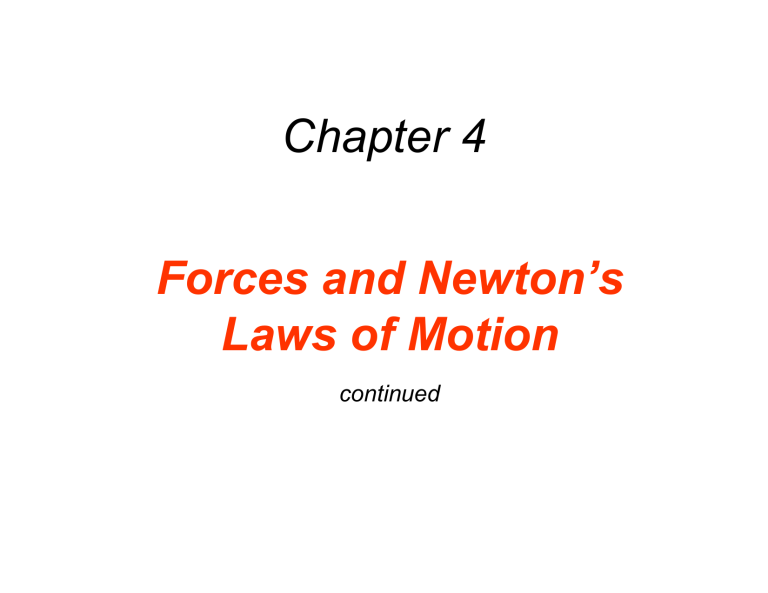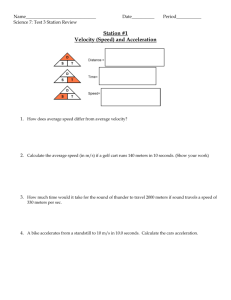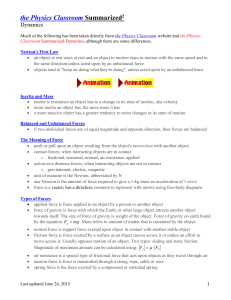Chapter 4 Forces and Newton's Laws of Motion

Chapter 4
Forces and Newton’s
Laws of Motion
continued
Quiz to follow
Newton’s laws of force and motion
1. An object continues in a state of rest or in a state of motion at a constant speed along a straight line , unless compelled to change that state by a net force.
(One object)
2. When a net external force acts on an object of mass m , the acceleration that results is directly proportional to the net force and has a magnitude that is inversely proportional to the mass. The direction of the acceleration is the same as the direction of the net force.
(One object)
3. Whenever one body exerts a force on a second body , the second body exerts an oppositely directed force of equal magnitude on the first body.
(Two objects in contact or attracted by gravity)
Quiz 3
1.
C&J page 90 (top), Check Your Understanding #3
2.
A car with a mass of 1500 kg and its driver with a mass of 100 kg, are accelerated by a force of 30,000 N. What force accelerates the driver? a) 200 N b) 30,000 N c) 1900 N d) 100 N e) 19 N
3. A 10,000 kg garbage truck and a 1000 kg Chevy Volt collide. At the point of collision, consider the magnitude of the forces acting, and decide which statement below is true. a) The force acting on the smaller mass is always the largest.
b) The force acting on the larger mass is always the largest.
c) The force acting on the vehicle with the highest speed is the largest . d) The force acting on the vehicle with the smallest speed is the largest.
e) The force acting on the two vehicles is always exactly the same.
4. There are two ropes and each applies a force of +40 N on mass of
30 kg. However, the mass exhibits an acceleration of –10 m/s 2 .
What other force (magnitude and direction) acts on the object? a) F
3
= 220 N –10 m/s 2 b) F
3
= 80 N
20 kg
+40 N c) F
3
= − 80 N
+40 N d) F
3
= − 100 N e) F
3
= − 380 N
5. Acting on a ball are two forces, each with a magnitude of 28 N, acting at
45° with the respect to the vertical direction. What single force will make the Net Force acting on the ball equal to zero?
y a) − 40 N b) – 14 N
F
= 28 N
45
°
45
°
F
= 28 N c) − 32 N d) − 18 N e) – 28 N
1.
Quiz 3
d) Net Force
⇔ acceleration
2.
A car with a mass of 1500 kg and its driver with a mass of 100 kg, are accelerated by a force of 30,000 N. What force accelerates the driver? a) b) 30,000 N c) d) 100 N e)
200 N
1900 N
19 N m
Both a a
=
=
= m
Car
F
B m
B
F m
D
D
=
⇒
30,000 N
1600 kg
F
+ m
Driver
D
= m
D a
=
=
=
1600 kg
19 m/s
(
2 ; for car,
100 kg
) (
19 m/s and for driver
2
)
= 1900 N
.
3. A 10,000 kg garbage truck and a Chevy Volt collide. At the point of collision, consider the magnitude of the forces acting, and decide which statement below is true. a) The largest force acts on the smallest mass.
b) The largest force acts on the largest mass.
c) The largest force acts on the vehicle with the highest speed. d) The largest force acts on the vehicle with the smallest speed.
e) The same force acts on both vehicles.
Newton's 3
rd
law!
4. There are two ropes and each applies a force of +40 N on mass of
30 kg. However, the mass exhibits an acceleration of –10 m/s 2 .
What third force (magnitude and direction) acts on the object? a) F
3
= 220 N –10 m/s 2 b) F
3 c) F
3 d) F
3
= 80 N
F
Net
20 kg
+40 N e) F
3
= − 80 N
= − 100 N
= − 380 N F
3
= F
3
F
3
(
80 N
= ma − + 80 N
)
; F
Net
= ma ;
+40 N
( )
= (30kg)( − 10m/s 2 ) − 80 N= − 380 N
5. Acting on a ball are two forces, each with a magnitude of 28 N, acting at
45° with the respect to the vertical direction. What single force will make the Net Force acting on the ball equal to zero? a) − 40 N
45
°
y
20 N b) – 12 N 28 N
F
= 28 N
45
°
y
45
°
F
= 28 N c) − 32 N d) − 18 N e) – 28 N y : F
Net
F
3
= 0 = 2
(
F
= − 2
(
F cos45 ° cos45 °
)
)
= − 40 N
+ F
3 F
3
4.7 The Gravitational Force
Newton’s Law of Universal Gravitation
Every particle in the universe exerts an attractive force on every other particle.
A particle is a piece of matter, small enough in size to be regarded as a mathematical point.
The force that each exerts on the other is directed along the line joining the particles.
4.7 The Gravitational Force
For two particles that have masses m
1 and m
2 and are separated by a distance r , the force has a magnitude given by the same magnitude of force acts on each mass, no matter what the values of the masses.
4.7 The Gravitational Force
4.7 The Gravitational Force
4.7 The Gravitational Force
Definition of Weight
The weight of an object on or above the earth is the gravitational force that the earth exerts on the object.
The weight always acts downwards, toward the center of the earth.
On or above another astronomical body, the weight is the gravitational force exerted on the object by that body.
SI Unit of Weight: newton (N)
4.7 The Gravitational Force
Relation Between Mass and Weight
WEIGHT is a force vector
W = G mM r 2
E
, downward
WEIGHT(magnitude) of mass m
W
= mg , g = G
M r 2
E
Your WEIGHT
W
WEIGHT DEFINITION
Your “weight” is the force that gravity applies on your body. r distance to center of the earth
4.7 The Gravitational Force
Near the earth’s surface
r
= R
E
= 6.38
× 10 6 m Radius of the earth g = G
M
E
R
E
2
=
(
6.67
× 10 − 11
= 9.80 m s 2
N ⋅ m 2 kg 2
)
(
(
5.98
× 10
6.38
× 10 6
24 kg
m
2
)
)
This is why acceleration due to gravity is this value on the earth.
Your WEIGHT on the earth
W
= mg for example: m = 80.0 kg,
W = mg = 784 N
4.7 The Gravitational Force
Near the earth’s surface
In orbit at altitude = 200 km 200 km
r
= R
E
g
= 9.80 m s 2 At radius of the earth
At 200 km above the earth r ′ = R
E
+ 200 km = 6.38
× 10 6 + 0.2
× 10 g ′ = 9.20 m s 2 g ′
=
=
6.58
GM r ′ 2
E
× 10
=
6 m
9.20 m/s 2
In low-earth orbit, your weight is almost the same as on earth. NOT ZERO!
6 m
Clicker Question 4.9
A person weighs 500 N on the earth. Consider this person on planet P where the acceleration due to gravity is, g
P
= 19 m/s 2 . Chose the answer that is false or answer e).
a) On the earth, the mass of the person is 51 kg.
b) Everywhere on the earth, the person has a mass of 51 kg.
c) On the planet P, the mass of the person is 51 kg.
d) On the planet P, the weight of the person is 970 N. e) All of the above are true.
Clicker Question 4.9
A person weighs 500 N on the earth. Consider this person on planet P where the acceleration due to gravity is, g
P
= 19 m/s 2 . Chose the answer that is false or answer e) a) On the earth, the mass of the person is 51 kg.
m
= W g = b) Everywhere on the earth, the person has a mass of 51 kg.
51 kg
True c) On the planet P, the mass of the person is 51 kg.
True d) On the planet P, the weight of the person is 970 N. W = mg
P e) All of the above are true.
= 970 N
4.7 The Gravitational Force
Can you feel gravity (the gravitational force) ?
Most people would say yes!
Consider standing on the concrete floor.
Gravity pulls down on you and compresses your body. You feel body mass is above them.
A) In your arms
B) In your legs
Consider hanging by your hands from a 100 m high diving board.
Gravity pull down on you and stretches your body.You feel most stretching A) In your arms
B) In your legs
Let go of the 100 m high diving board.
While gravity accelerates you downward, what do you feel ?
You don’t feel stretched, and you don’t feel compressed.
You feel “weightless”, yes, but your weight is still W = mg .
4.7 The Gravitational Force
The ONLY thing a person can feel is a stretch or compression of your body parts, mostly at a point of contact. If your body is not stretched or compressed, you will feel like you are floating.
Gravity ALONE will not stretch or compress your body.
Hanging from the board, the board also pulls up on your arms.
Newton’s 3 rd law!
Standing on the ground, the ground also pushes up on the bottom of your feet. Newton’s 3 rd law!
While falling, the earth pulls on you and you pull on the earth.
Gravity requires no contact. YOU CANNOT FEEL GRAVITY.
4.8 The Normal Force
Definition of the Normal Force
The normal force is one component of the force that a surface exerts on an object with which it is in contact – namely, the component that is perpendicular to the surface.
F
N
sometimes written as
F
⊥
F
⊥
(perpendicular to surface)
W
4.8 The Normal Force
F
Net
=
F
⊥
= F
⊥
+ W
+
(
−
+
F
H
F
⊥
=
: Normal (or perpendicular) force
⊥
is the magnitude
0
H
= − 11N
⊥
11 N
)
+
(
− 15 N
)
F
⊥
= + 26 N
W
= + 26 N
= − 15N
F
Net
F
⊥
=
=
F
⊥
F
⊥
+
F
H
+ W
(
= 0
+ 11 N+ − 15 N
)
= + 4 N
H
= 11N
⊥
= +
W
= − 15N
4 N
4.8 The Normal Force
Apparent Weight = Normal force acting on an object
The apparent weight of an object is the reading of the scale.
It is equal to the normal force the scale exerts on the man.
Also, by Newton’s 3 rd law
It is equal to the normal force the man exerts on the scale.
=
−
g
700 N 1000 N a
400 N a
0 N
Acceleration a = 0 , v constant
Acceleration a , upward
Acceleration a , downward
Free fall a = g, downward
4.8 The Normal Force
For the person being accelerated (
a
)
F
⊥
= F
upward
⊥
,
+ F
⊥
F
⊥
∑
F
y
+ W
=
F
⊥
= ma
+ W ;
+
( )
= ma
F
⊥
= mg + ma
∑
F y
= ma
W = mg , downward apparent weight true weight a upward: apparent weight > true weight a downward: apparent weight < true weight








